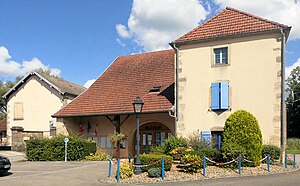Cuve
| Cuve | ||
|---|---|---|
|
|
||
| region | Bourgogne-Franche-Comté | |
| Department | Haute-Saône | |
| Arrondissement | Lure | |
| Canton | Port-sur-Saône | |
| Community association | Haute Comté | |
| Coordinates | 47 ° 54 ' N , 6 ° 13' E | |
| height | 232-335 m | |
| surface | 8.10 km 2 | |
| Residents | 141 (January 1, 2017) | |
| Population density | 17 inhabitants / km 2 | |
| Post Code | 70800 | |
| INSEE code | 70194 | |
 Mairie Cuve |
||
Cuve is a municipality in the French department of Haute-Saône in the region Bourgogne Franche-Comté .
geography
Cuve is located at an altitude of 245 m above sea level, 5 km northwest of Saint-Loup-sur-Semouse and about 32 km north of the city of Vesoul (as the crow flies). The village extends in the far north of the department, slightly elevated on the northern edge of the Dorgeon basin, on the edge of the Vôge plateau .
The area of the 8.10 km² municipal area covers a section in the gently undulating landscape on the edge of the Vôge. From north-west to south-east, the area is crossed by the alluvial valley of the Dorgeon, which provides drainage via the Lanterne to the Saône . The valley level is on average 235 m and has a maximum width of one kilometer. The Ruisseau du Pont Mirot flows from the north at Cuve . The valley is flanked on both sides by a plateau, which is divided by the hollows of short side valleys of the Dorgeon. To the south-west the parish soil extends to the height of La Levue (up to 280 m). Agricultural use prevails here. North of the Dorgeon, the plateau gradually rises to the wooded heights of the Grand Bois . The highest elevation of Cuve is reached here at 335 m.
In geological and tectonic terms, the main part of the municipal area consists of shell limestone from the Middle Triassic . To the north of this is a narrow zone with sandy-marl and calcareous sediments that were deposited during the Lias ( Lower Jurassic ). Further north, red sandstone from the Lower Triassic comes to light.
Neighboring municipalities of Cuve are Fontenoy-le-Château in the north, Bouligney in the east, Anjeux in the south and Dampvalley-Saint-Pancras in the west.
history
In the Middle Ages, Cuve belonged to the Free County of Burgundy and in it to the area of the Bailliage d'Amont . The monastery of Luxeuil held local rule . The existence of a noble family with the name Cuve has been documented since 1372. Together with Franche-Comté , the place finally came to France with the Peace of Nijmegen in 1678.
Attractions
The Saint-Remi church was rebuilt in 1775 and has paintings from the 18th and 19th centuries. A Calvaire and the large manor house date from the 18th century . The covered lavoir , which once served as a wash house and cattle trough, was built in the 19th century.
Lavoir Cuve
population
| Population development | |
|---|---|
| year | Residents |
| 1962 | 119 |
| 1968 | 122 |
| 1975 | 135 |
| 1982 | 114 |
| 1990 | 118 |
| 1999 | 153 |
| 2006 | 151 |
With 141 inhabitants (January 1, 2017) Cuve is one of the small communities in the Haute-Saône department. After the population had decreased significantly in the first half of the 20th century (335 people were still counted in 1881), after a long period of stagnation, slight population growth has been recorded again since the early 1990s.
Economy and Infrastructure
Until well into the 20th century, Cuve was a village dominated by agriculture (arable farming, viticulture and cattle breeding) and forestry. Today there are some local small businesses. In the last few decades the village has transformed into a residential community. Many workers are therefore commuters who work in the larger towns in the area.
The village is well developed in terms of traffic. It is close to the main road D417 that goes from Luxeuil-les-Bains to Bourbonne-les-Bains . Other road connections exist with Fontenoy-le-Château, Dampvalley-Saint-Pancras and Anjeux.


